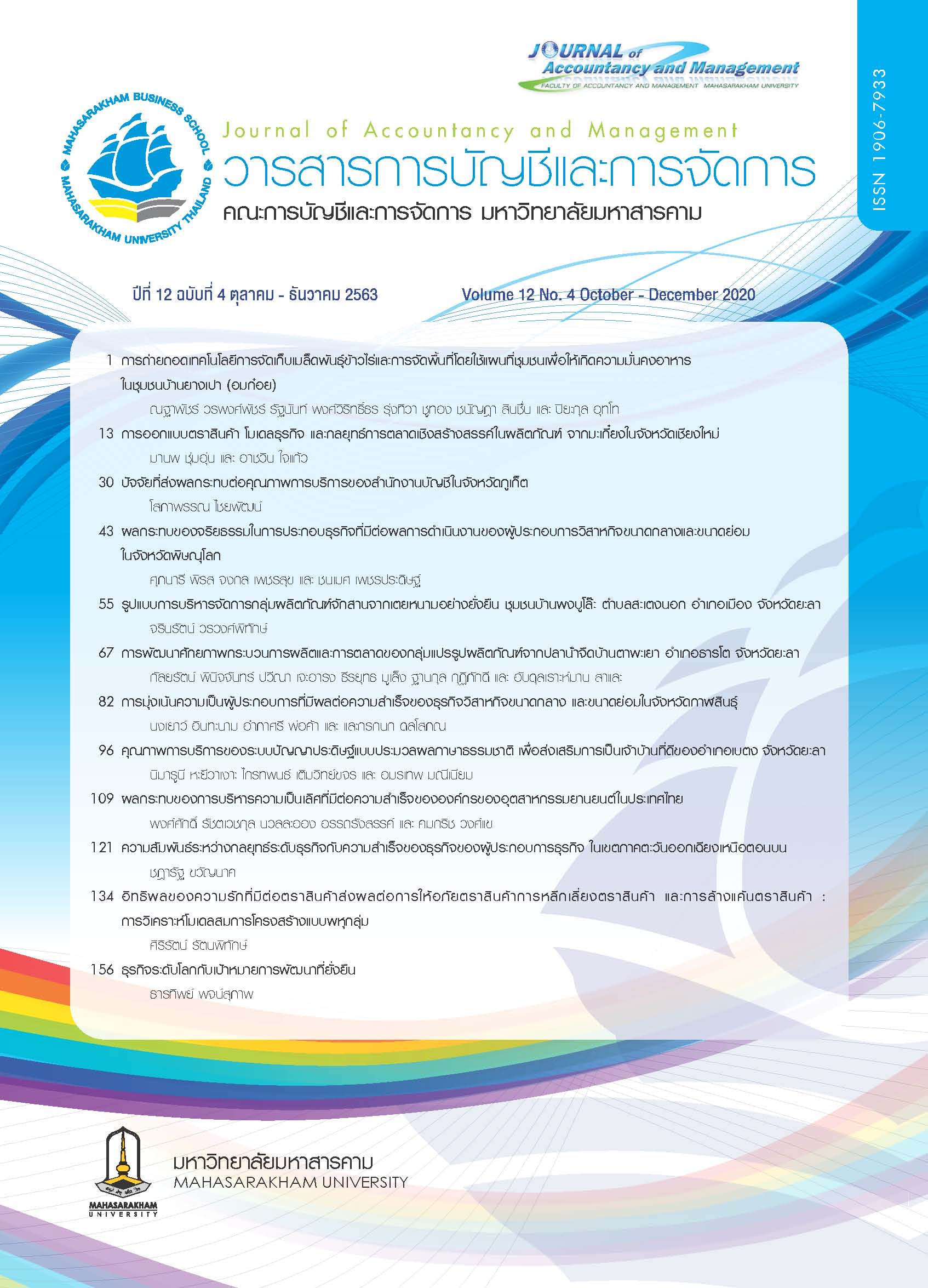การออกแบบตราสินค้า โมเดลธุรกิจ และกลยุทธ์การตลาด เชิงสร้างสรรค์ในผลิตภัณฑ์จากมะเกี๋ยงในจังหวัดเชียงใหม่
Main Article Content
บทคัดย่อ
การวิจัยมีวัตถุประสงค์เพื่อวิเคราะห์สถานการณ์การตลาด พฤติกรรมผู้บริโภค และห่วงโซ่อุปทานผลิตภัณฑ์มะเกี๋ยง ออกแบบตราสินค้าและบรรจุภัณฑ์เพื่อสร้างการรับรู้ใหม่ในผลิตภัณฑ์จากมะเกี่ยง และสร้างโมเดลธุรกิจผลิตภัณฑ์จากมะเกี่ยงเพื่อใช้ประโยชน์ทางการพาณิชย์ เก็บข้อมูลด้วยการสำรวจบริบทชุมชน การสัมภาษณ์เชิงลึก การสนทนากลุ่ม กลุ่มตัวอย่างเลือกแบบเจาะจง คือ กลุ่มเกษตรแปรรูปผลิตภัณฑ์บ้านบวกเปา อำเภอสันทราย จังหวัดเชียงใหม่ จำนวน 40 คน วิเคราะห์ข้อมูลด้วยการวิเคราะห์เนื้อหา ผลการศึกษาพบว่า ผู้บริโภคส่วนใหญ่จะซื้อมะเกี๋ยง ทั้งผลสดและผลิตภัณฑ์แปรรูป โดยกลุ่มลูกค้าในชุมชน โรงเรียนและวัดในชุมชน สาเหตุที่ซื้อเพราะเห็นว่าสามารถรับประทานได้เหมือนผลไม้ทั่วไป และยังมีคุณประโยชน์และคุณค่าสารอาหารมาก ช่องทางการซื้อคือตลาดสด ตลาดนัดชุมชนและร้านค้าชุมชน ด้านห่วงโซ่อุปทานระดับต้นน้ำพบว่าที่ดินปลูกมะเกี๋ยงทั้งหมดจะเป็นของสมาชิกกลุ่ม แต่จะปลูกเฉพาะบางครัวเรือนเท่านั้น แรงงานการผลิตทั้งหมดมาจากสมาชิกกลุ่ม และใช้เงินออมของสมาชิกในการดำเนินงาน ส่วนการกระจายสินค้าจะใช้รถมอเตอร์ไซด์และรถกระบะของสมาชิก ด้านการสร้างตราสินค้าและบรรจุภัณฑ์ พบว่า กลุ่มใช้ตราร่วมสำหรับผลิตภัณฑ์แปรรูปจากมะเกี๋ยงทุกประเภท มีโลโก้เป็นรูปผลมะเกี๋ยงสุขและมีใบมะเกี๋ยงล้อมรอบ ใช้สโลแกนโฆษณาคือมะเกี๋ยงจากธรรมชาติแท้ 100 % ส่วนบรรจุภัณฑ์มีหลายขนาดทั้งชนิดขวดแก้ว ขวดพลาสติก กระปุก และกล่องพลาสติกและวางตำแหน่งการแข่งขันในตลาดไปที่ความเป็นมะเกี๋ยงสดและปลอดภัย ด้านกลยุทธ์ส่วนประสมการตลาด พบว่า กลยุทธ์กลยุทธ์ผลิตภัณฑ์คือการสร้างความเชื่อมั่นว่าผลิตอย่างปลอดภัย กลยุทธ์ราคาสำหรับกลุ่มตลาดชุมชนใช้กลยุทธ์ราคาต่ำ กลุ่มตลาดระดับกลางขึ้นไปตั้งราคาสูง กลยุทธ์ ช่องทางการจัดจำหน่ายใช้การขายผ่านร้านค้าของกลุ่ม ตลาดสด และตลาดนัด กลยุทธ์การโฆษณาใช้แผ่นพับและ โบรชัวร์ การส่งเสริมการขายคือการทดลองใช้หรือบริโภคฟรี ผลการสร้างโมเดลธุรกิจ พบว่า กำหนดกลุ่มลูกค้าไปที่กลุ่มในชุมชนและกลุ่มตลาดระดับกลางขึ้นไปที่ซื้อ หรือใช้เพื่อประโยชน์เฉพาะอย่าง เช่น เพื่อสุขภาพ เพื่อทดแทนผลไม้อื่น หรือมีความปลอดภัยตามหลักโภชนาการ โดยเน้นคุณประโยชน์ที่โดดเด่นคือความเป็นผลไม้ถิ่นที่ปลูกแบบธรรมชาติ และมีคุณค่าทางสารอาหาร
Downloads
Article Details
บทความที่ได้รับการตีพิมพ์เป็นลิขสิทธิ์ของวารสารการบัญชีและการจัดการ
ข้อความที่ปรากฏในบทความแต่ละเรื่องในวารสารวิชาการเล่มนี้เป็นความคิดเห็นส่วนตัวของผู้เขียนแต่ละท่านไม่เกี่ยวข้องกับมหาวิทยาลัยมหาสารคาม และคณาจารย์ท่านอื่นๆในมหาวิทยาลัยฯ แต่อย่างใด ความรับผิดชอบองค์ประกอบทั้งหมดของบทความแต่ละเรื่องเป็นของผู้เขียนแต่ละท่าน หากมีความผิดพลาดใดๆ ผู้เขียนแต่ละท่านจะรับผิดชอบบทความของตนเองแต่ผู้เดียว
เอกสารอ้างอิง
กนกกาญจน์ เกตุแก้ว. (2562). โมเดลธุรกิจและการนำไปดำเนินการ. วารสารการจัดการสมัยใหม่. 17(1), 1-12.
กมลวรรณ กาศลุน. (2557). กลยุทธ์การสร้างตราอินเทอร์เน็ตสำหรับเว็บไซต์พาณิชย์อิเล็กทรอนิกส์. วารสารวิจัยมหาวิทยาลัยสวนดุสิต, 10(1), 77-96.
จุฑารัตน์ กลิ่นประทุม และพัฒน์ พัฒนรังสรรค์ .(2559). ปัจจัยที่มีผลต่อการซื้อผลิตภัณฑ์ชาชงสมุนไพรในเขตเมืองพัทยา. วารสารบัณฑิตศึกษา, 13(21), 205-214.
ชาญชัย อาจินสมาจาร. (2551). หลักการตลาด. กรุงเทพฯ : ปัญญาชน.
ณัฐเศรษฐ์ น้ำคำ และสุรชัย บุญเจริญ. (2561). การจัดการห่วงโซ่ข้าวกลุ่มวิสาหกิจชุมชน ลุ่มแม่น้ำเจ้าพระยา. วารสารวิชาการคณะเทคโนโลยีอุตสาหกรรม มหาวิทยาลัยราชภัฏลำปาง, 10(1), 40-49.
ดนัย จันทร์เจ้าฉาย และภัทรพงศ์ พงศ์สวัสดิ์. (2549). การตลาดนอกกรอบ แนวคิดกลยุทธ์หยุดโลก. [Lateral Marketing] กรุงเทพฯ : ดีเอ็มจี. (ต้นฉบับพิมพ์ปี ค.ศ. 2003).
ฐาปนา บุญหล้า และนงลักษณ์ นิมิตภูวดล. (2555). การจัดการโลจิสติกส์ : มิติซัพพลายเชน. กรุงเทพฯ : ซีเอ็ดยูเคชั่น.
ไทบาวน์, อลิช เอ็ม. (2551). การสร้างแบรนด์ของ Kellogg. [Kellogg on Branding] (ปฏิพล ตั้งจักรวรานนท์, แปล) กรุงเทพฯ : เอ็กซเปอร์เน็ท. (ต้นฉบับพิมพ์ปี ค.ศ. 2005).
ธัญวรัตน์ วงเวียน และดรุณี นาพรหม. (2559). ผลของพาโคลบิวทราโซลต่อการเติบโตทางกิ่งใบของมะเกี๋ยง. วารสารเกษตร, 32(3), 321-330.
นรเทพ ผิวทองอ่อน นงนภัส เที่ยงกมล และธนรรรตต์ คู่วรัญญู เที่ยงกมล. (2562). รูปแบบการซื้อสินค้าที่เป็นมิตรต่อสิ่งแวดล้อม. วารสารเกษมบัณฑิต, 20 (ฉบับพิเศษ), 121-128.
นันทสารี สุขโตและคณะ (2560). หลักการตลาด. (พิมพ์ครั้งที่ 3). กรุงเทพฯ : เพียร์สัน เอ็ดดูเคชั่น อินโดไชน่า.
นัทธ์หทัย เถาตระกูล. (2562). การออกแบบตราสินค้าและบรรจุภัณฑ์ของกลุ่มธุรกิจชุมชนในอำเภอแม่สะเรียง จังหวัดแม่ฮ่องสอน. วารสารการบัญชีและการจัดการ มหาวิทยาลัยมหาสารคาม, 11(2), 100-117.
เนตรนภา อุ่นทิ และฉัตรภา หัตถโกศล. (2562). ประโยชน์ต่อสุขภาพของผลไม้ตระกูลเบอรี่ที่ปลูกได้ในประเทศไทย. วารสารโภชนาการ, 54(2), 94-105.
ปณิตา แจ้ดนาลาว และธรินี มณีศรี. (2563). รูปแบบการจัดการโซ่อุปทานวิสาหกิจชุมชนกลุ่มสินค้าเกษตรอย่างยั่งยืน. วารสารชุมชนวิจัย มหาวิทยาลัยราชภัฏนครราชสีมา, 14(1), 133-145.
ปัทมาพร ท่อชู และวิทยา อินทร์สอน. การออกแบบตราสัญลักษณ์หรือโลโก้เพื่อธุรกิจ (Logo Design for Business. ค้นเมื่อ 23 พฤศจิกายน 2562. จาก http://www.thailandindustry.com/onlinemag/view2.php?id=643§ion=4&issues=
พีรภาว์ ทวีสุข. (2556). อิทธิกลของกลยุทธ์การตลาดและวิถีการดำเนินชีวิตของผู้ซื้อต่อการประเมินภายหลังการซื้อสินค้าเกษตรอินทรีย์ในประเทศไทย. คณะบริหารธุรกิจ มหาวิทยาลัยเกษมบัณฑิต.
วิทยา จารุพงศ์โสภณ. (2556). กลยุทธ์การบริหารแบรนด์. กรุงเทพฯ : แปลน สารา
ศิริวรรณ เสรีรัตน์ และคณะ. (2546). พฤติกรรมผู้บริโภค. กรุงเทพฯ : วิสิทธิ์ วัฒนา.
สถาบันเทคโนโลยีราชมคล สถาบันวิจัย และฝึกอบรมการเกษตรลำปาง. (2563). งานวิจัย. ค้นเมื่อ 19 ตุลาคม 2563, จาก https://atri.rmutl.ac.th/page/research
สุกัญญา สุจาคำ. (2559). กลยุทธ์การตลาดเพื่อยกระดับมาตรฐานผลิตภัณฑ์วิสาหกิจชุมชนกลุ่มกะลานำโชค ตำบลร่วมจิต อำเภอท่าปลา จังหวัดอุตรดิตถ์. วารสารวิชาการมหาวิทยาลัยราชภัฏอุตรดิตถ์, 11(1), 260-268.
สุดาพร กุณฑลบุตร (2552). หลักการตลาดสมัยใหม่. กรุงเทพฯ : โรงพิมพ์แห่งจุฬาลงกรณ์มหาวิทยาลัย
สุธาวัลย์ สัจจสมบูรณ์ และธีว์วรา ไหวดี (2561). กลยุทธ์การสร้างความแตกต่าง เครื่องมือในการสร้างความได้เปรียบ ทางการแข่งขัน. วารสารการบริหารการปกครองและนวัตกรรมท้องถิ่น, 2 (3), 83-92.
สุมาลี ทองรุ่งโรจน์. (2555). Packaging Design. กรุงเทพฯ : วาดศิลป์.
สุเมธ อ่องเภา. (2558). การปรับปรุงพันธุ์มะเกี๋ยงเพื่อการแปรรูปเป็นน้ำผลไม้พร้อมดื่ม. กรมวิชาการเกษตร.
สุรชัย ศรีนรจันทร์ และบุหงา ชัยสุวรรณ. (2562). กระบวนการสร้างตราสินค้าและการสื่อสารการตลาดออนไลน์สินค้าเกษตรอินทรีย์. วารสารวิชาการเกษตร, 37(2), 177-185.
สำนักงานนโยบายและยุทธศาสตร์การค้า (2563). แนวโน้มของตลาดอาหารและเครื่องดื่มของไทย. ค้นเมื่อ 3 กรกฎาคม 2563. จาก https://www.facebook.com/TPSO.MOC/?
อรรนพ เรืองกัลปวงศ์ และสราวรรณ์ เรืองกัลปวงศ์. (2558). ปัจจัยที่มีความสัมพันธ์กับการตัดสินใจเลือกบริโภคผลิตภัณฑ์อาหารสุขภาพของผู้สูงอายุในกรุงเทพมหานคร. กรุงเทพมหานคร : คณะวิทยาการจัดการ มหาวิทยาลัยสวนดุสิต.
อนุรักษ์ อาทิตย์กวิน และคณะ. (2562). การสร้างมูลค่าเพิ่มสินค้าเซรามิกด้วยวิธีการพัฒนารูปแบบบรรจุภัณฑ์ เพื่อโอกาสทางการแข่งขันของผู้ประกอบการธุรกิจขนาดย่อม ประเภทของใช้ ของตกแต่ง และของที่ระลึกในจังหวัดลำปาง. วารสารบัณฑิตศึกษา มหาวิทยาลัยราชภัฏเชียงราย, 12(1), 1-12.
อิมะสึ มิกิ. (2557). Business Model Generation Work Book สร้างโมเดลธุรกิจ ง่ายนิดเดียว. [Business Model Generation Work Book] (โยซูเกะ, แปล). กรุงเทพฯ: วีเลิร์น. (ต้นฉบับพิมพ์ ปี ค.ศ. 2013).
ไอโคบัคซี, ดอน. (2551). การบริหารการตลาดของ Kellogg. [Kellogg on Marketing] (ณัฐยา สินตระการผล, แปล). กรุงเทพฯ : เอ็กซเปอร์เน็ท. (ต้นฉบับพิมพ์ปี ค.ศ. 2005).
Brown, S. (2016). Brands and Branding. London : SAGE.
Barwise, P. (2006). Marketer’s Toolkit. U.S.A. : Harvard Business School Press
Crawford, M., & Benedetto, A. D. (2015). New Products Management. (11th.ed.). New York : McGraw-Hill Education.
Gereffi, G., Bamber, P., Frederick, S., & Fernandez -Stark, K., (2013). Costa Rica In Global Value Chains : An Upgrading Analysis. Duke Center on Globalization, Governance & Competitiveness. North Carolina : Durham.
Gunelius, S. (2016). Brand Positioning for a Competitive Edge – Part 1: Competitive Positioning Strategy. Retrieved May 27, 2019, from https://aytm.com/blog/ research-junction/brand-positioning-for-a-competitive-edge-part-1/
Kapferer, J.N. (2008). New Strategic Brand Management : Creating and Sustaining Brand Equity Long Term. (4th ed.). London : Kogan Page.
Miles, M. B., & Huberman, A.M. (1994). Qualitative data analysis : An expanded sourcebook : Sage Publications, Inc.
Nastasi, B.K., & Schensul, S.L. (2005). Contributions of qualitative research to the validity of intervention research. Journal of School Psychology, 43(3), 177-195.
Osterwalder, A., & Pigneur, Y. (2010). Business Model Generation. New Jersey : John Wiley & Sons.
Porter, M., (1985). Competitive Advantage : Creating and Sustaining Superior Performance. New York : Free Press.
Ries, A., & Throut, J. (2001). Positioning the Battle for Your Mind. New York : McGraw-Hill.
Srivastava, R. K., & Metz, T. G. (2016). The Future of Branding. New Delhi : Sage Publications India.


